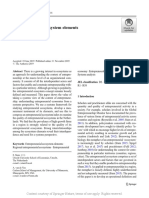RRL Nov 14
RRL Nov 14
Uploaded by
Nancy AtentarCopyright:
Available Formats
RRL Nov 14
RRL Nov 14
Uploaded by
Nancy AtentarOriginal Title
Copyright
Available Formats
Share this document
Did you find this document useful?
Is this content inappropriate?
Copyright:
Available Formats
RRL Nov 14
RRL Nov 14
Uploaded by
Nancy AtentarCopyright:
Available Formats
The Effects of a Remedial Math Intervention on Standardized Test Scores in Georgia
Middle Schools
by Chastity London Adams 2011
Literature related to remedial education was reviewed to ascertain information
and previous research available on the impact of remediation on test scores. The review
of literature is divided into five sections. The first section discusses current legislation
and its impact on schools and students. The second section explores response to
intervention (RTI). The legislation and intervention components offer valuable input into
educational decisions. The third section examines research on math interventions. The
fourth section highlights the theoretical background for remedial education and the
available research on remedial education in mathematics. The fifth section discusses
research on gender difference in mathematics to better understand how gender
differences may have an effect on interventions. Finally, the sixth section summarizes
the findings of the literature review.
Schools are looking for interventions to improve academic achievement and increase
test
scores due to the requirements of No Child Left Behind. One such intervention in middle
schools is remedial math. This causal comparative study examined the differences in
the
standardized test scores for at-risk students who receive remedial math instruction and
atrisk
students who do not receive this intervention. In addition, this study examined
gender differences for the remedial math students. The Georgia Criterion-Referenced
Competency Test of 293 at-risk seventh-grade students was used in this study. Using
the
previous year’s standardized math test scores as a control variable, there was a
significant
relationship between at-risk students taking remedial math and higher scores on
standardized tests, regardless of gender.
History of remediation. Colleges and universities have provided remediation to
students for many years. Student scores on entrance exams and/or standardized
testing,
such as the ACT and SAT, are used to determine if students will be required to take
remedial courses in reading, writing, and mathematics. According to a study published
in
2000 by the U.S. Department of Education, 22% of entering college freshmen were
enrolled in a remedial math course (Wirt et al., 2004).
While remedial courses, specifically math courses, have been prevalent in the
post-secondary environment, remediation of secondary school children has not routinely
been offered as a course during the school day. However, the introduction of NCLB,
changes to IDEA, and the onset of response to intervention (RTI) have begun to change
the delivery of remediation to students. Schools are required to provide struggling
students with support using the RTI model. Students who are not successful in the
classroom or do not meet the standards on standardized tests are moved from Tier 1 on
the RTI model to Tier 2. Tier 2 students must receive additional support. Remediation
can be considered as a Tier 2 intervention.
Challenges of remediation. Studies completed on the effectiveness of remedial
courses have provided insight on some challenges. Research on post-secondary
remediation reveals that students who are required to take one or more remedial
mathematics courses are more likely to change their course of study or not finish their
college program (Attawell, 2006; Bahr, 2007). Considering this information, one might
35
assume attrition is an issue for students in remedial programs. However, the research
reports that, of the students who took remedial courses, most passed the courses
successfully and usually finished their first year of college (Attawell, 2006). The
research findings are contradictory. It can be determined through these findings that
these students were successful at completing the remedial course but not successful at
completing a post-secondary course of study. Therefore, it cannot be determined that
remediation is part of the problem; however, one can determine that with 22% of college
freshmen needing math remediation (Wirt et al., 2004), remedial courses are needed in
the secondary school setting (Esch, 2009; Schachter, 2008). The research examined
did
not reveal any findings for secondary schools to deal with attrition or high school
dropout
rates.
Providing a curriculum that challenges and motivates students is another difficult
task for remedial education (Bahr, 2007; Bahr, 2008; Patrick, n.d.). Remedial instruction
must be more than simply repeating instruction (Patrick, n.d.). Repeating the same
instruction that the students did not understand the first time will not assist students in
gaining the needed concepts. Students must be taught using engaging curriculum. Bahr
(2007, 2008) has found that the depth and breadth of the curriculum can affect student
success. “Depth of remedial need refers to degree of deficiency in a given subject, while
breadth of remedial need refers to the number of basic skill areas in which a given
student
requires remedial assistance: (Bahr, 2007, p. 698).
Benefits of remediation. While teaching remedial math courses can be a
challenge for educators, remediation has been shown to improve the math performance
of
students in secondary schools (Bottge et al. 2001; Bushweller, 1998; Fletcher, 1998;
Mross, 2003; Schultz, 1991). Research completed by Bottge et al. (2001) and Fletcher
(1998) revealed that middle school students taking remedial math courses were able to
improve their grades in mathematics after remediation. Secondary education students
participating in the research completed by Fletcher (1998) were said to go from failure
to
honor roll. Students in these remedial programs gained organizational skills and
increased understanding. While it is clear that the math grades of students increased as
a
result of remediation, researchers have failed to investigate the impact of remedial
instruction on standardized testing.
A limited number research studi
Schools cannot consider just any research-driven intervention; other factors must
be considered. First, schools must determine which intervention will best fit the needs of
their students. For example, how long will the intervention last, and how much material
will be covered. If considering a remedial program, schools must recognize that positive
results have been shown for short programs, like summer school, but the duration of
benefits is questioned. Additionally Schultz (2001) argued that short-term programs
have
carried the baggage of poor attendance and are often not as effective. Research on
remedial programs supports increased depth and breadth to increase and sustain
studentlearning
outcomes (Bahr, 2007, 2008).
Schools must also consider cost associated with these programs to help determine
the most beneficial and cost-effective method to assist students. Schools can save
money
on utilities and transportation costs encountered with afterschool and summer school
programs by offering a remedial course during the school day. These programs can be
offered as an elective course, minimizing cost. Schools would save on utilities,
Based on evidence provided in this study, remedial courses are effective for both
genders when examining standardized test scores. Research on math ability and
performance on standardized tests based on gender is inconclusive. Liu and Wilson
(2009) reported that male scores reveal a small but consistent advantage over females
when examining standardized tests in mathematics. However, other research shows
similar growth trends over time for both males and females (Din et al., 2006; Rosselli et
al., 2009). The No Child Left Behind Act's requirements for schools to make adequate
yearly progress and students to pass standardized testing for promotion make it
important
to consider gender when looking at the benefits of adding a remedial math course as a
Tier 2 intervention. Remedial math must benefit all students, regardless of gender, to be
considered as an effective intervention for addressing the requirements of NCLB.
Grouping of students with similar needs developed affiliation in the remedial
math courses examined in this study. All students in the remedial math class were
missing skills necessary to meet their grade-level math standards. Affiliation is another
theme that can be found in research as an effective method of instruction and
remediation
(Flores & Kaylor, 2007; Hoffman & Brahier, 2008; Kroeger & Kouche, 2006).
Affiliation involves interaction between students and their peers and teachers. Through
this interaction, students are able to develop understanding of important concepts and
create connections to assist them in effectively learning the material. Affiliation is
important in remedial programs. The students who needed remediation did not fully
understand and make connections to the material being taught. Affiliation can assist in
making these connections, making remediation successful (Flores & Kaylor, 2007;
Hoffman & Brahier, 2008; Kroeger & Kouche, 2006).
Pupils in remedial classes
Anna-Lena Ljusberg
Anna-Lena Ljusberg, Stockholm 2009
ISBN 978-91-7155-802-2
Printed in Sweden by Universitetsservice AB, Stockholm 2009
Distributor: Department of Child and Youth Studies, Stockholm University
It has become increasingly common for schools in Sweden to attempt to
solve difficult classroom situations by moving pupils to a remedial class,
often called a “little group” (Ljusberg, in press; Matson, 2007). There are
many reasons for moving a pupil to a little group. Some of these are to allow
the pupils to avoid a difficult situation, to gain time to catch up, and to give
them opportunities to concentrate (Brodin & Lindstrand, 2004). One of the
teachers interviewed for this thesis declared that “it can be easier to move a
pupil than a teacher” (Ljusberg, in press). Separate teaching groups are not
new phenomena; they have been in existence for as many years as Sweden
has had compulsory education (Brodin & Lindstrand, 2004; Elowson, 1995).
There has also been a parallel discussion of the advantages and disadvantages
of segregated instruction.
You might also like
- Investigating The Effect of An Adaptive Learning Intervention On Students' LearningDocument21 pagesInvestigating The Effect of An Adaptive Learning Intervention On Students' LearningcharlesNo ratings yet
- The Little Mermaid Was Written in 1837 by Hans Christian AndersenDocument1 pageThe Little Mermaid Was Written in 1837 by Hans Christian AndersenNancy AtentarNo ratings yet
- Class Size Project 1Document13 pagesClass Size Project 1lenco4eva6390100% (2)
- LESSON EXEMPLAR in PR 2 - Week 1 FinalDocument2 pagesLESSON EXEMPLAR in PR 2 - Week 1 FinalNancy Atentar100% (1)
- Work Sheet in Accounting 1Document12 pagesWork Sheet in Accounting 1Nancy Atentar50% (2)
- Linear Regression Approach To Academic PerformanceDocument27 pagesLinear Regression Approach To Academic PerformanceDessyNo ratings yet
- CHAPTER I To II III BeaDocument8 pagesCHAPTER I To II III BeaNeil DonioNo ratings yet
- Chapters 1, 2, & 3Document26 pagesChapters 1, 2, & 3DAN MONTAJNo ratings yet
- 20261-Article Text-52430-1-10-20161221Document18 pages20261-Article Text-52430-1-10-20161221Molindu AchinthaNo ratings yet
- Do Extracurricular Activities Matter? Chapter 1: IntroductionDocument18 pagesDo Extracurricular Activities Matter? Chapter 1: IntroductionJason Wong100% (1)
- The Enigma of Academics Revealing The Positive Effects of School Attendance Policies. FINAL. 2Document8 pagesThe Enigma of Academics Revealing The Positive Effects of School Attendance Policies. FINAL. 2Angelica CarreonNo ratings yet
- Chapter 1Document10 pagesChapter 1Abcedef Wyn Grey AbrasadoNo ratings yet
- Inbound 8649275232433946042Document13 pagesInbound 8649275232433946042Cj Naynay OsuyaNo ratings yet
- Jde ArticleDocument10 pagesJde Articleapi-249395603No ratings yet
- No Child Left BehindDocument6 pagesNo Child Left BehindJonathan TyNo ratings yet
- DocumentDocument15 pagesDocumenteboyjumampasNo ratings yet
- Bonvin 2003 The Role of Teacher Attitudes and Judgement in Decision Making The Case of Grade RetentionDocument18 pagesBonvin 2003 The Role of Teacher Attitudes and Judgement in Decision Making The Case of Grade RetentionlptcutieeeNo ratings yet
- Homework Has Positive Effect On Student Achievement Duke StudyDocument8 pagesHomework Has Positive Effect On Student Achievement Duke Studyerdqfsze100% (1)
- Adjustment To College and Academic Performance Insights From Filipino College Freshmen in An Allied Health Science CourseDocument43 pagesAdjustment To College and Academic Performance Insights From Filipino College Freshmen in An Allied Health Science CourseMalu ArchividoNo ratings yet
- Fractions and DecimalsDocument30 pagesFractions and DecimalsEliseo MarpaNo ratings yet
- Chapter 2Document23 pagesChapter 2Ronelle San buenaventuraNo ratings yet
- Paper Information: Next Paper Previous Paper Paper SubmissionDocument11 pagesPaper Information: Next Paper Previous Paper Paper SubmissionAnonymous 5YpmpYbStNo ratings yet
- Ej 1068208Document12 pagesEj 1068208Average Internet SurferNo ratings yet
- TheEffectOfBlendedCoursesOnStudent PreviewDocument22 pagesTheEffectOfBlendedCoursesOnStudent PreviewDwi AnggareksaNo ratings yet
- Math Works ResourcesDocument7 pagesMath Works ResourcesAchieve, Inc.No ratings yet
- Raising ExpectationsDocument19 pagesRaising ExpectationsvivektonapiNo ratings yet
- CHAPTER 2Document7 pagesCHAPTER 2Dave PayodNo ratings yet
- Webb, Brigman, and Campbell 05Document8 pagesWebb, Brigman, and Campbell 05Veronica ChiriacNo ratings yet
- Factors Leading To Poor Performance in Problem Solving Skills in Mathematics of Selected 5th Grade of Pulot Shore Elementary SchoolDocument16 pagesFactors Leading To Poor Performance in Problem Solving Skills in Mathematics of Selected 5th Grade of Pulot Shore Elementary SchoolAmmad Roslan100% (2)
- Academic Stress and Coping Strategies of Learning Mathematics Through Modular InstructionDocument9 pagesAcademic Stress and Coping Strategies of Learning Mathematics Through Modular InstructionPsychology and Education: A Multidisciplinary JournalNo ratings yet
- SEII Discussion Paper 2019.07 SetrenDocument36 pagesSEII Discussion Paper 2019.07 SetrenCameron LeeNo ratings yet
- Problem Solving ModelsDocument6 pagesProblem Solving ModelsCristina GomezNo ratings yet
- "Backwash Effects" of Testing On Learning MathematicsDocument24 pages"Backwash Effects" of Testing On Learning MathematicsAmadeus Fernando M. PagenteNo ratings yet
- CHAPTERSDocument65 pagesCHAPTERSHavenNo ratings yet
- Final Mat 701Document19 pagesFinal Mat 701api-356505889No ratings yet
- Shahzadi and AhmedDocument14 pagesShahzadi and Ahmedزيدون صالحNo ratings yet
- Chapter 1 Sample QuantitativeDocument18 pagesChapter 1 Sample QuantitativemiyakakinareeolitasabasNo ratings yet
- The Effects of Peer-Led Supplemental Sessions On Students in An Undergraduate Calculus CourseDocument13 pagesThe Effects of Peer-Led Supplemental Sessions On Students in An Undergraduate Calculus Courseapi-352538610No ratings yet
- The Impact of Working Student in Academic Performance of Grade 12 HUMSS Student at Leyte National High SchoolDocument12 pagesThe Impact of Working Student in Academic Performance of Grade 12 HUMSS Student at Leyte National High SchoolxyxycalabiaNo ratings yet
- A Path To Personal Growth - Exploring Challenges and Coping Strategies of Mathematics Major StudentsDocument92 pagesA Path To Personal Growth - Exploring Challenges and Coping Strategies of Mathematics Major Studentsgerardatole15No ratings yet
- Remedying Ed QJEDocument31 pagesRemedying Ed QJEAlejandro ZunoNo ratings yet
- 07 Chapter 7Document16 pages07 Chapter 7Lovely ann BantiloNo ratings yet
- AbstractDocument9 pagesAbstractsamuel kolawoleNo ratings yet
- Peer Tutoring Chapter 1 2Document4 pagesPeer Tutoring Chapter 1 2Aaliyah Kim QuintoNo ratings yet
- Review of Related Literature and StudiesDocument8 pagesReview of Related Literature and StudiesJohn MatiasNo ratings yet
- Effects and Challenges To Implement Differentiated Mathematics Teaching Among Fourth 2100-13204-1-PBDocument11 pagesEffects and Challenges To Implement Differentiated Mathematics Teaching Among Fourth 2100-13204-1-PBDijana VučkovićNo ratings yet
- PR Group 4Document13 pagesPR Group 4marifemisiona301No ratings yet
- Student Perceptions of Classroom Learning: Plus Ça Change, Plus C'est La Même Chose?Document24 pagesStudent Perceptions of Classroom Learning: Plus Ça Change, Plus C'est La Même Chose?Diana VillaNo ratings yet
- Relationship Between Pre-Service Teachers' Mathematics Self-Efficacy and Their Mathematics AchievementDocument14 pagesRelationship Between Pre-Service Teachers' Mathematics Self-Efficacy and Their Mathematics AchievementMuh YusufNo ratings yet
- Effects of an Inclusion Professional Development Model on Inclusion Knowledge and Perceptions of Regular Middle School EducatorsFrom EverandEffects of an Inclusion Professional Development Model on Inclusion Knowledge and Perceptions of Regular Middle School EducatorsNo ratings yet
- Cong EvDocument2 pagesCong EvCASushiNo ratings yet
- Pre-Service Teachers' Procedural and Conceptual Knowledge of FractionsDocument5 pagesPre-Service Teachers' Procedural and Conceptual Knowledge of FractionsJASH MATHEW100% (1)
- Student Outcomes 1 Running Head: Community College Student OutcomesDocument14 pagesStudent Outcomes 1 Running Head: Community College Student OutcomesRobin Rice GarzaNo ratings yet
- The Effects of Family Background and SCH PDFDocument49 pagesThe Effects of Family Background and SCH PDFjefferson Acedera ChavezNo ratings yet
- The Effectiveness m3 CourseDocument34 pagesThe Effectiveness m3 CourseNaz ZackNo ratings yet
- 10 5923 J Nursing 20150502 04 PDFDocument6 pages10 5923 J Nursing 20150502 04 PDFAvegail MansalapusNo ratings yet
- Response To Intervention and Test ScoresDocument18 pagesResponse To Intervention and Test Scoresapi-251745467No ratings yet
- Ej 1079859Document14 pagesEj 1079859prb lianaNo ratings yet
- Chapter 11Document26 pagesChapter 11joy garciaNo ratings yet
- Gracia - An ExplorationDocument16 pagesGracia - An ExplorationLadyromancerWattpadNo ratings yet
- The Enigma of Academics Revealing The Positive Effects of School Attendance Policies. FINAL. 2 2Document6 pagesThe Enigma of Academics Revealing The Positive Effects of School Attendance Policies. FINAL. 2 2Angelica CarreonNo ratings yet
- Previous MC 8Document15 pagesPrevious MC 8dawkhinkhatkhatkhaing.k4No ratings yet
- Gender Etc.Document3 pagesGender Etc.Lucky Esports0% (1)
- SUMMATIVE TEST IN BUSSINESS MATH - Quarter 1Document8 pagesSUMMATIVE TEST IN BUSSINESS MATH - Quarter 1Nancy AtentarNo ratings yet
- SWAB - DISS - Week 1-8Document5 pagesSWAB - DISS - Week 1-8Nancy AtentarNo ratings yet
- Online Donations: Donation PageDocument6 pagesOnline Donations: Donation PageNancy AtentarNo ratings yet
- SUMMATIVE TEST IN Bread & Pastry - Quarter 1Document3 pagesSUMMATIVE TEST IN Bread & Pastry - Quarter 1Nancy Atentar100% (5)
- Grade 12: Weekly Home Learning Plan For Disaster Readiness & Risk ReductionDocument4 pagesGrade 12: Weekly Home Learning Plan For Disaster Readiness & Risk ReductionNancy AtentarNo ratings yet
- Grade 12-Nobility / Chastity: Weekly Home Learning Plan For Disaster Readiness & Risk ReductionDocument3 pagesGrade 12-Nobility / Chastity: Weekly Home Learning Plan For Disaster Readiness & Risk ReductionNancy AtentarNo ratings yet
- Precalculus:: Conic Sections: CirclesDocument19 pagesPrecalculus:: Conic Sections: CirclesNancy AtentarNo ratings yet
- Math - District Presentation 2021Document9 pagesMath - District Presentation 2021Nancy AtentarNo ratings yet
- Action Research Proposal 2021Document3 pagesAction Research Proposal 2021Nancy AtentarNo ratings yet
- Idea Lesson Nancy - Fabm2 FinalDocument4 pagesIdea Lesson Nancy - Fabm2 FinalNancy AtentarNo ratings yet
- Lesson Exemplar: Foundamentals of Accountancy & Business Management 2Document5 pagesLesson Exemplar: Foundamentals of Accountancy & Business Management 2Nancy AtentarNo ratings yet
- Idea Lesson Nancy - Fabm2 FinalDocument4 pagesIdea Lesson Nancy - Fabm2 FinalNancy AtentarNo ratings yet
- Characteristics of Vak LearnersDocument6 pagesCharacteristics of Vak LearnersNancy AtentarNo ratings yet
- Certificate of Participation: Nancy T. AtentarDocument1 pageCertificate of Participation: Nancy T. AtentarNancy AtentarNo ratings yet
- Deped - Division of Quezon: Score Sheet For Master Teacher I ApplicantsDocument5 pagesDeped - Division of Quezon: Score Sheet For Master Teacher I ApplicantsNancy Atentar100% (2)
- 2019 Deped Transmutation Table PDFDocument1 page2019 Deped Transmutation Table PDFNancy AtentarNo ratings yet
- Briones MessageDocument1 pageBriones MessageNancy AtentarNo ratings yet
- Checking of Forms 2020 SHSDocument2 pagesChecking of Forms 2020 SHSNancy AtentarNo ratings yet
- The Richness of The Philippines in Terms of Mineral Resources Is Being Attributed To Its Location in The So-CalledDocument3 pagesThe Richness of The Philippines in Terms of Mineral Resources Is Being Attributed To Its Location in The So-CalledNancy AtentarNo ratings yet
- 4 Quarterly Examination in Tle 7: Name: - Grade and SectionDocument3 pages4 Quarterly Examination in Tle 7: Name: - Grade and SectionNancy AtentarNo ratings yet
- 4TH QUARTERLY Examination in ENGLISH 7Document2 pages4TH QUARTERLY Examination in ENGLISH 7Nancy AtentarNo ratings yet
- Entre P Quiz Chapter 1Document2 pagesEntre P Quiz Chapter 1Brian DuelaNo ratings yet
- Case Study 2Document5 pagesCase Study 2sweetjar22No ratings yet
- Book Legal Reasoning Electronic EditionDocument582 pagesBook Legal Reasoning Electronic EditionBorgy Ambulo67% (3)
- LDM Feedback Report: Name of Teacher: - Vincent Y. Librea SubjectDocument6 pagesLDM Feedback Report: Name of Teacher: - Vincent Y. Librea SubjectErvince Librea100% (2)
- R.B. Dav Sr. Sec Public School, Bathinda: "A Great Place To Learn and Grow"Document2 pagesR.B. Dav Sr. Sec Public School, Bathinda: "A Great Place To Learn and Grow"piyushk96793No ratings yet
- Trends and Issues in LDWMDocument2 pagesTrends and Issues in LDWMElonah Mae Galande -BEEDNo ratings yet
- Group I ResultsDocument3 pagesGroup I Resultsnavn76No ratings yet
- Entrepreneurial Ecosystem ElementsDocument25 pagesEntrepreneurial Ecosystem ElementsAlade TemitayoNo ratings yet
- Lesson Plan-Correct22Document4 pagesLesson Plan-Correct22api-238792976No ratings yet
- Ragdale Visual Arts Intensive Brochure Email1Document2 pagesRagdale Visual Arts Intensive Brochure Email1api-267416800No ratings yet
- Ched Comparative Sched of Fees TemplatesDocument129 pagesChed Comparative Sched of Fees Templatesmelvanne tamboboyNo ratings yet
- The Reality of WitchcraftDocument10 pagesThe Reality of WitchcraftLibertad BaumNo ratings yet
- Sandeep C.VDocument2 pagesSandeep C.Vsandeep sharmaNo ratings yet
- Grade 11-Adm Learning Resource Introduction To The Philosophy of The Human PersonDocument6 pagesGrade 11-Adm Learning Resource Introduction To The Philosophy of The Human PersonMark AcopNo ratings yet
- How To Get Into Dental School - SU 2014 PDFDocument35 pagesHow To Get Into Dental School - SU 2014 PDFSanjay VeerasammyNo ratings yet
- ASSESSMENT of Learning DissabiltiesDocument39 pagesASSESSMENT of Learning DissabiltiesAnghela Mayumi MarquezNo ratings yet
- Mysticalgod's Astrological ChartDocument27 pagesMysticalgod's Astrological ChartMysticalgod UidetNo ratings yet
- Communicating in Groups Applications and Skills 9th EditionDocument61 pagesCommunicating in Groups Applications and Skills 9th Editionkevin.verne147100% (57)
- SBM Practices MOV-TA Levels 1-6 - With TA Needed BlankDocument10 pagesSBM Practices MOV-TA Levels 1-6 - With TA Needed BlankSylvio Hermoso Sabino100% (7)
- Membership Form PDFDocument1 pageMembership Form PDFexcelino bueno jrNo ratings yet
- Pharmacy Technician Job Description ResumeDocument4 pagesPharmacy Technician Job Description Resumee7dqxazz100% (1)
- QnA PaathshalaDocument3 pagesQnA PaathshalaOm JoshiNo ratings yet
- Red Scarf Girl AnalysisDocument2 pagesRed Scarf Girl Analysisgigi_wong3eNo ratings yet
- Introduction To Global Strategic Management: Click To Edit Master Subtitle StyleDocument24 pagesIntroduction To Global Strategic Management: Click To Edit Master Subtitle StyleParas GuptaNo ratings yet
- The Effect of Online Game Addiction and Learning Concentration On Social Science Students' Learning Outcomes in Eight Grage of Private Junior High School Kartika 1-4 Pematang SiantarDocument4 pagesThe Effect of Online Game Addiction and Learning Concentration On Social Science Students' Learning Outcomes in Eight Grage of Private Junior High School Kartika 1-4 Pematang SiantarMonika GuptaNo ratings yet
- ALICK CHOMPOLOLA - PMC Data Collection Application LetterDocument11 pagesALICK CHOMPOLOLA - PMC Data Collection Application LetterNchimunya Alik Chompolola100% (1)
- SEM 5 SCHEDULE 2023 RevisedDocument2 pagesSEM 5 SCHEDULE 2023 Revisedmuskangupta13o89No ratings yet
- Positive Impacts of AI On HumansDocument1 pagePositive Impacts of AI On HumansdedaNo ratings yet
- Chapter 1 Quiz & Answers Chapter 1 Quiz & AnswersDocument5 pagesChapter 1 Quiz & Answers Chapter 1 Quiz & AnswersShubhada Amane100% (1)
- "The Cultural School of Thought": "Summary"Document5 pages"The Cultural School of Thought": "Summary"Sadia AsifNo ratings yet
















































































































